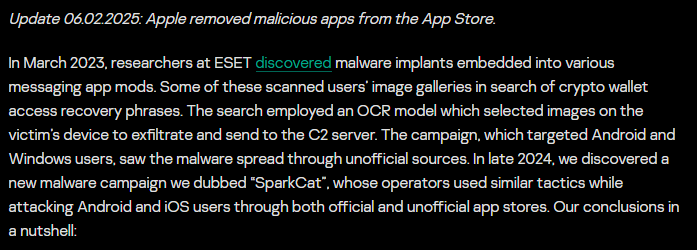A new cybersecurity threat is targeting crypto users worldwide. According to Kaspersky, a recently discovered malware named SparkCat is designed to steal crypto wallet recovery phrases by infiltrating smartphone galleries.
How Does SparkCat Work?
SparkCat operates by embedding itself into seemingly harmless applications, such as food delivery services and AI-powered chatbots. Once installed, the malware scans the phone’s gallery for screenshots containing sensitive data, including seed phrases, passwords, and other financial information.
Hidden in Everyday Apps
The malware was initially found in apps available on both Google Play and the App Store, active since March 2024. Before being taken down, it had already infected approximately 242,000 users. Reports suggest that this cyber attack primarily targeted users in Europe and Asia, with strong indications that it originated from China.

The Growing Threat to Crypto Users
Unlike traditional crypto scams, which often involve fraudulent investment schemes and meme tokens, SparkCat takes a different approach by directly compromising users’ devices. By bypassing security measures and extracting crucial wallet details, this malware poses a serious risk to investors.
Although Kaspersky has not disclosed the exact amount of stolen cryptocurrency, experts warn that the attack method demonstrates a shift in crypto crime tactics—focusing on personal security breaches rather than large-scale phishing scams.
How to Protect Your Crypto Assets
To avoid falling victim to such attacks, The Bit Journal recommends taking the following precautions:
- Never store recovery phrases as screenshots or text files on your phone.
- Use two-factor authentication (2FA) for additional security.
- Download applications only from verified developers and read reviews before installation.
- Keep your device’s operating system and security software updated.
- Consider using a hardware wallet for storing crypto assets.
As cybercriminals continue to evolve, staying informed and implementing strong security measures is crucial for protecting your crypto investments.
- https://twitter.com/Thebitjournal_
- https://www.linkedin.com/company/the-bit-journal/
- https://t.me/thebitjournal
Follow us on Twitter and LinkedIn and join our Telegram channel to get instant updates on breaking news!






























